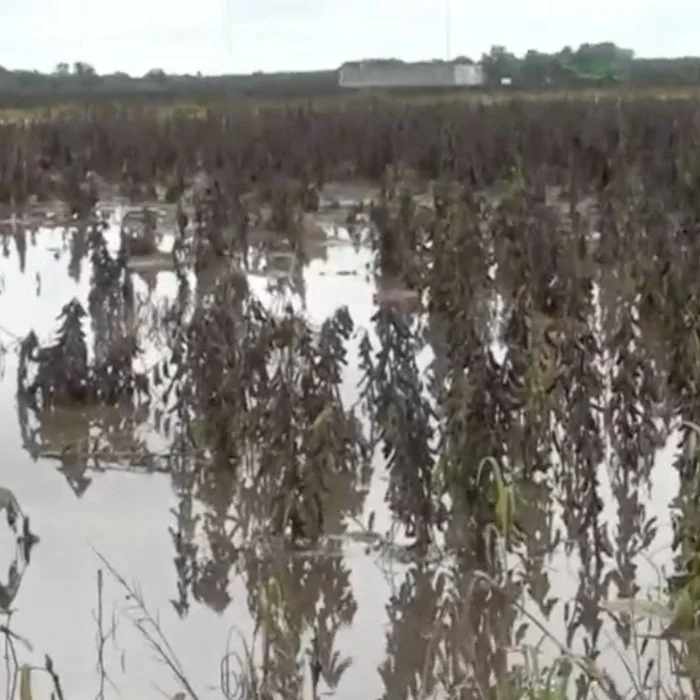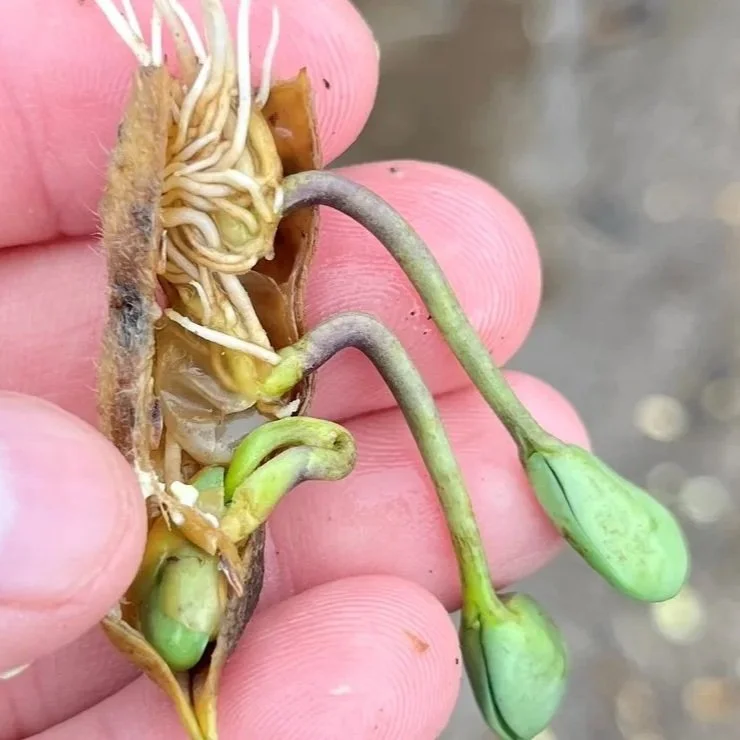Louisiana corn for grain production is forecast at 71.8 million bushels, down 15 percent from the August 1 forecast and down 31 percent from 2021. Based on conditions as of September 1, yield is expected to average 165 bushels per acre, down 10 bushels from last month and down 18 bushels from last year.
Read MoreHit by inflation, farmers around the country have dealt with unprecedented input prices this year, and inclement weather has taken a toll on their yields.
Farmers in Louisiana have also dealt with inflated prices of everything from fuel to fertilizer, and unfavorable weather conditions mean smaller yields, shrinking their margins even smaller.
Read MoreFor the first time in 46 years, the Old River locks are being drained so they can be repaired.
“The only way for us to get our crops on the market is through the river,” Curt Engemann said.
Read MoreNortheast Louisiana farmers are concerned about having food to harvest after rainfall swept through the region, specifically soybeans.
Concordia Parish plants more acres of soybeans than anywhere in the state of Louisiana, according to ANR Agent Kylie Miller of the LSU Ag Center. The damage to soybeans will significantly affect the parish and state economies.
Read MoreThere’s been lots of rain in the forecast across the state and even here in Southwest Louisiana, and while the rain is great for crops, too much rain can be a different story.
“If it keeps doing this, we have some beans that are almost ready to harvest, if rain keeps setting in like it has been, they are just going to deteriorate,” said local farmer David Smith.
Read MoreParts of the Louisiana Delta region are waterlogged just as several soybean farmers were close to harvest.
RFD-TV's Tammi Arender caught up with Chris Johnson, who farms soybeans, corn, and wheat.
Read MoreU.S. soybeans, compared to soybeans of other origins, bring a lot of value to the table for end users, which brings returns to yours. Because of that, your soy checkoff continuously invests in research to keep U.S. soybean meal top of mind for end users.
Read MoreLouisiana soybean farmers are facing disaster as torrential rains continue to pound the crop at its most vulnerable point on the cusp of what had promised to be a bumper harvest just 10 days ago.
"It's bad; really bad," said Tensas Parish producer Ben Guthrie, who family planted about 4,000 acres of soybeans this year. "It's already pretty clear that there is a good bit of sprouting and rot and pod degradation, and it's still raining."
Read MoreAs we approach late into the summer, we should be on the lookout for late-season lepidopteran pests of soybean. Soybean loopers can build large populations in a short amount of time and can be exaggerated by the use of broad-spectrum insecticides for stink bugs and three-cornered alfalfa hoppers.
Read MoreThe 2022/23 U.S. corn outlook for this month calls for lower supplies, reduced feed and residual use, slightly higher food, seed, and industrial use, smaller exports, and lower ending stocks. Projected beginning stocks for 2022/23 are 20 million bushels higher based on a lower use forecast for 2021/22, where a reduction in corn used for ethanol is partially offset by greater use for glucose and dextrose.
Read MoreThe Crop Production report issued Friday by USDA's National Agricultural Statistics Service (NASS) forecasted corn production down from 2021 and soybean production up from last year. Corn production is down 5% from last year, forecast at 14.4 billion bushels; soybean growers are expected to increase their production 2% from 2021, forecast at 4.53 billion bushels.
Read MoreUSDA released its August Crop Production report on Aug. 12 and the survey-based report has farmers indicating corn yields will reach 175.4 bushels per acre and soybean yields at a record 51.9 bushels per acre in 2022. This is despite extreme heat and sporadic rainfall throughout the countryside.
Read MoreLouisiana corn for grain production is forecast at 84.9 million bushels, down 18 percent from 2021. Based on conditions as of August 1, yield is expected to average 175 bushels per acre, down 8 bushels from last year. Producers expect to harvest 485,000 acres of corn for grain, down 80,000 acres from 2021.
Read MoreThe farmer-leaders of the United Soybean Board (USB) convened for its summer board meeting on July 26-27 in Kalamazoo, Michigan, to approve a 2023 fiscal year budget of $123M for program work, starting Oct. 1, 2022. Spanning eight portfolios, these investments in research, education and promotion add value to U.S. soybeans with the goal to build resilience, differentiation and reputation. This portfolio ladders up to USB's new vision of delivering sustainable soy solutions to every life, every day.
Investment portfolios will continue the board's work of creating consistent, long-term domestic and global market opportunities to further demand for U.S.-grown soybeans.
"Our thinking, planning and work as a board has become a much more deliberate and idea-driven process, challenging our board members to think big. Each portfolio is farmer-directed and works together to create demand for U.S. soybeans across the entire global soy value chain," said Ralph Lott, USB Chair and farmer from New York. "We've successfully shifted from project takers to portfolio makers, and the end result is more strategic thinking. The preference for U.S. soybeans grows while farmers continue to see strong ROI on their checkoff dollars."
Investment portfolios are approved by the full board and consist of programs across Supply and Demand Action Teams driven by the three priority areas of 1) Innovation & Technology, 2) Health & Nutrition, and 3) Infrastructure & Connectivity. FY23 programs impact everything from improving production on the farm to expanding markets across animal agriculture, soyfoods and providing a renewable alternative for biofuels and nonfood uses. Some examples of these soy checkoff investments aim to:
Enhance soybean cropping system improvement that creates opportunities to reward and support farmers and other value chain participants, including the growth of high oleic soybean production to meet demand for specialty soybeans while providing a farmer premium.
Further soy's role in the evolving clean energy movement, with investments that support using soybean oil as a feedstock for biodiesel and renewable diesel in marine, rail and on-road applications. Biofuels are the largest industrial use for soybean oil and require investments to reach maximum potential.
Develop nutrition and health research that distinguishes U.S. soybean meal's value drivers (amino acids and energy), supports animal health, builds evidence that discerns U.S. soybean meal from the competition and strengthens key industry partnerships.
Encourage commodity partnerships to improve soil health, collaborating with National Corn Growers Association and National Pork Board to implement cover crops on 30 million acres of soybeans and corn by 2030, focused on meeting sustainability goals while improving farmer productivity.
Grow exports in more than 80 countries through the U.S. Soybean Export Council's strategy to differentiate U.S. soybeans in the global marketplace. USB also partners with the U.S. Meat Export Federation and the USA Poultry and Egg Export Council to promote exports of soy-fed meat, as well as the American Soybean Association's World Initiative for Soy in Human Health to create long-term demand for U.S. soybeans in developing and emerging markets and improve food security.
Improve best management practices through partnerships that lead to faster, real-time dissemination of pest and disease research findings, such as developing a pesticide and fungicide calculation tool that helps farmers determine regional application thresholds to maximize yield potential.
Increase focus on fertilizers and biologicals that support farmers and farming system resilience in an uncertain crop input market environment.
Reach key audiences to elevate the reputation of U.S. soybeans, expanding trust with consumers and helping them develop a deeper understanding and appreciation for how U.S. soybean farmers can deliver sustainable solutions for more than 1,000 renewable products on the market.
"Over the past year, we've changed the way we make investment decisions. The new Value Alignment Committee gives farmer-leaders more input in the types of programs the checkoff supports. Today marks the culmination of that new process," said Meagan Kaiser, USB Vice Chair and farmer from Missouri. "This is a new, exciting direction, and we couldn't be successful without our state and national farmer volunteers and checkoff partners who work diligently on behalf of the 515,000 U.S. soybean farmers. I also want to extend thanks to the Michigan Soybean Committee for hosting this memorable meeting and showcasing the diversity of Michigan agriculture."
About United Soybean Board:
United Soybean Board's 78 volunteer farmer-leaders work on behalf of all U.S. soybean farmers to achieve maximum value for their soy checkoff investments. These volunteers create value by investing in research, education and promotion with the vision to deliver sustainable soy solutions to every life, every day across the three priority areas of Infrastructure & Connectivity, Health & Nutrition, and Innovation & Technology. As stipulated in the federal Soybean Promotion, Research and Consumer Information Act, the USDA Agricultural Marketing Service has oversight responsibilities for USB and the soy checkoff. For more information on the United Soybean Board, visit unitedsoybean.org.
The farmer-leaders of the United Soybean Board (USB) convened for its summer board meeting on July 26-27 in Kalamazoo, Michigan, to approve a 2023 fiscal year budget of $123M for program work, starting Oct. 1, 2022. Spanning eight portfolios, these investments in research, education and promotion add value to U.S. soybeans with the goal to build resilience, differentiation and reputation.
Read More














